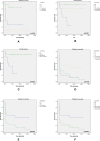Single-Nucleotide Polymorphisms Within Non-HLA Regions Are Associated With Engraftment Effectiveness for Patients With Unrelated Cord Blood Transplantation
- PMID: 35769457
- PMCID: PMC9234117
- DOI: 10.3389/fimmu.2022.888204
Single-Nucleotide Polymorphisms Within Non-HLA Regions Are Associated With Engraftment Effectiveness for Patients With Unrelated Cord Blood Transplantation
Abstract
Clinically, stem cells with matched human leukocyte antigens (HLAs) must be selected for allogeneic transplantation to avoid graft rejection. However, adverse reactions still occur after cord blood transplantation (CBT). It was inferred that the HLA system is not the only regulatory factor that may influence CBT outcomes. Therefore, we plan to investigate whether the single-nucleotide polymorphisms (SNPs) located in non-HLA genes are associated with the effectiveness of CBT. In this study, the samples of 65 donors from CBT cases were collected for testing. DNA sequencing was focused on the SNPs of non-HLA genes, cytotoxic T-lymphocyte-associated protein 4 (CTLA4), CD28, tumor necrosis factor ligand superfamily 4 (TNFSF4), and programmed cell death protein 1 (PDCD1), which were selected in regard to the literatures published in 2017 and 2018, which indicated that they were related to stem cell transplantation. Then, in combination with the detailed follow-up transplantation tracking database, these SNPs were analyzed with the risk of mortality, relapse, cytomegalovirus (CMV) infection, and graft-versus-host disease (GVHD). We found that there were 2 SNPs of CTLA4, 1 SNP of TNFSF4, and 2 SNPs of PDCD1 associated with the effectiveness of unrelated CBT. These statistically significant SNPs and haplotypes would be used in clinical to choose the best donor for the patient receiving CBT. Moreover, the polygenic risk scores (PRSs) with these SNPs could be used to predict the risk of CBT adverse reactions with an area under the receiver operating characteristic curve (AUC) of 0.7692. Furthermore, these SNPs were associated with several immune-related diseases or cancer susceptibility, which implied that SNPs play an important role in immune regulation.
Keywords: CD28; CTLA4; PDCD1; TNFSF4; cord blood transplantation (CBT); non-HLA genes; single-nucleotide polymorphism (SNP).
Copyright © 2022 Chen, Jaing, Hour, Lin and Hsu.
Conflict of interest statement
The authors declare that the research was conducted in the absence of any commercial or financial relationships that could be construed as a potential conflict of interest.
Figures


Similar articles
-
The Association Between Single-Nucleotide Polymorphisms of Co-Stimulatory Genes Within Non-HLA Region and the Prognosis of Leukemia Patients With Hematopoietic Stem Cell Transplantation.Front Immunol. 2021 Oct 4;12:730507. doi: 10.3389/fimmu.2021.730507. eCollection 2021. Front Immunol. 2021. PMID: 34671352 Free PMC article.
-
Single nucleotide polymorphisms within HLA region are associated with the outcomes of unrelated cord blood transplantation.Sci Rep. 2021 Nov 9;11(1):21925. doi: 10.1038/s41598-021-01155-z. Sci Rep. 2021. PMID: 34753965 Free PMC article.
-
Exploration of the association between the single-nucleotide polymorphism of co-stimulatory system and rheumatoid arthritis.Front Immunol. 2023 Jun 29;14:1123832. doi: 10.3389/fimmu.2023.1123832. eCollection 2023. Front Immunol. 2023. PMID: 37457686 Free PMC article.
-
Guidelines for the Prevention and Management of Graft-versus-Host Disease after Cord Blood Transplantation.Transplant Cell Ther. 2021 Jul;27(7):540-544. doi: 10.1016/j.jtct.2021.03.012. Transplant Cell Ther. 2021. PMID: 34210500 Review.
-
Association of cytotoxic T-lymphocyte antigen-4 (CTLA-4) single nucleotide polymorphism in donors with clinical outcome after allogeneic hematopoietic stem cell transplantation: a meta-analysis.Hematology. 2021 Dec;26(1):144-152. doi: 10.1080/16078454.2020.1852762. Hematology. 2021. PMID: 33491603
Cited by
-
Exploring the Bio-Functional Effect of Single Nucleotide Polymorphisms in the Promoter Region of the TNFSF4, CD28, and PDCD1 Genes.J Clin Med. 2023 Mar 10;12(6):2157. doi: 10.3390/jcm12062157. J Clin Med. 2023. PMID: 36983159 Free PMC article.
References
-
- Wagner JE, Rosenthal J, Sweetman R, Shu XO, Davies SM, Ramsay NK, et al. Successful Transplantation of HLA-Matched and HLA-Mismatched Umbilical Cord Blood From Unrelated Donors: Analysis of Engraftment and Acute Graft-Versus-Host Disease. Blood (1996) 88(3):795–802. doi: 10.1182/blood.V88.3.795.795 - DOI - PubMed
-
- Takahashi S, Iseki T, Ooi J, Tomonari A, Takasugi K, Shimohakamada Y, et al. Single-Institute Comparative Analysis of Unrelated Bone Marrow Transplantation and Cord Blood Transplantation for Adult Patients With Hematologic Malignancies. Blood (2004) 104(12):3813–20. doi: 10.1182/blood-2004-03-1001 - DOI - PubMed
-
- Gluckman E, Rocha V, Boyer-Chammard A, Locatelli F, Arcese W, Pasquini R, et al. Outcome of Cord-Blood Transplantation From Related and Unrelated Donors. Eurocord Transplant Group and the European Blood and Marrow Transplantation Group. N Engl J Med (1997) 337(6):373–81. doi: 10.1056/NEJM199708073370602 - DOI - PubMed
Publication types
MeSH terms
Substances
LinkOut - more resources
Full Text Sources
Medical
Research Materials

